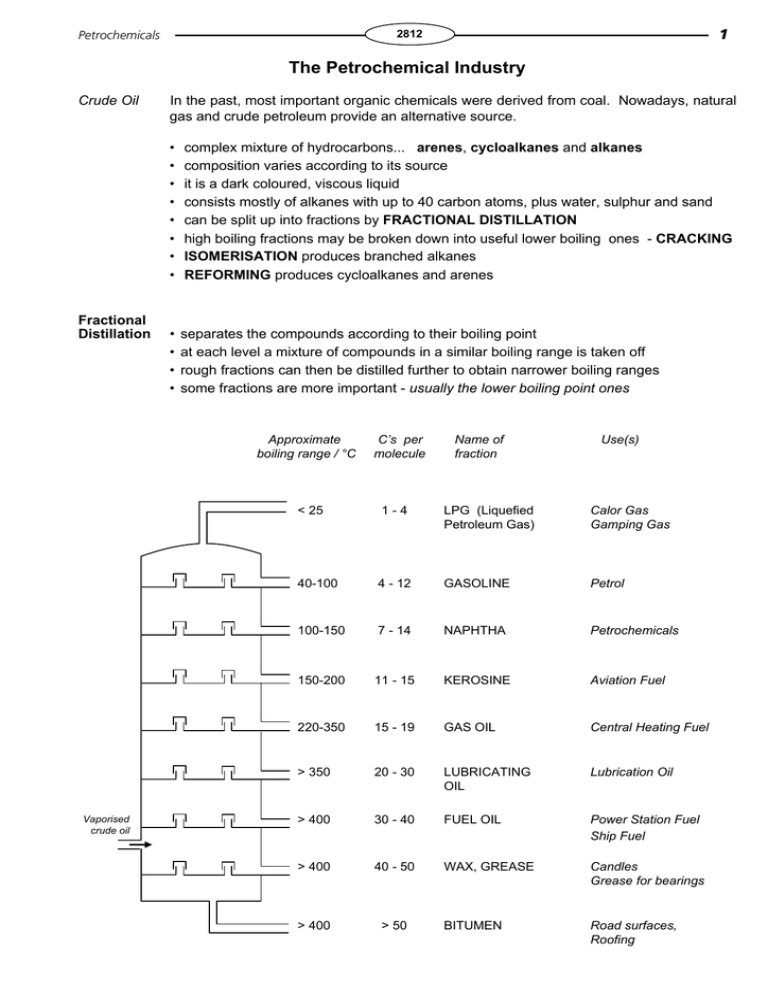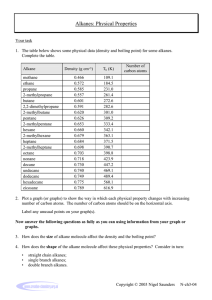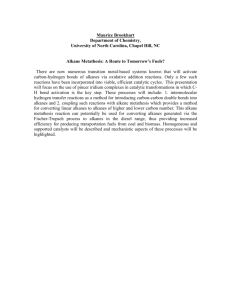The Petrochemical Industry 1
advertisement

Petrochemicals 1 2812 The Petrochemical Industry Crude Oil Fractional Distillation In the past, most important organic chemicals were derived from coal. Nowadays, natural gas and crude petroleum provide an alternative source. • • • • • • • • complex mixture of hydrocarbons... arenes, cycloalkanes and alkanes composition varies according to its source it is a dark coloured, viscous liquid consists mostly of alkanes with up to 40 carbon atoms, plus water, sulphur and sand can be split up into fractions by FRACTIONAL DISTILLATION high boiling fractions may be broken down into useful lower boiling ones - CRACKING ISOMERISATION produces branched alkanes REFORMING produces cycloalkanes and arenes • • • • separates the compounds according to their boiling point at each level a mixture of compounds in a similar boiling range is taken off rough fractions can then be distilled further to obtain narrower boiling ranges some fractions are more important - usually the lower boiling point ones Approximate boiling range / °C Vaporised crude oil C’s per molecule Name of fraction Use(s) < 25 1-4 LPG (Liquefied Petroleum Gas) Calor Gas Gamping Gas 40-100 4 - 12 GASOLINE Petrol 100-150 7 - 14 NAPHTHA Petrochemicals 150-200 11 - 15 KEROSINE Aviation Fuel 220-350 15 - 19 GAS OIL Central Heating Fuel > 350 20 - 30 LUBRICATING OIL Lubrication Oil > 400 30 - 40 FUEL OIL Power Station Fuel Ship Fuel > 400 40 - 50 WAX, GREASE Candles Grease for bearings > 400 > 50 BITUMEN Road surfaces, Roofing 2 Petrochemicals 2812 CRACKING Process • involves the breaking of C-C bonds in alkanes • converts heavy fractions into higher value products • two types THERMAL THERMAL CATALYTIC Free radical mechanism Carbocation (carbonium ion) mechanism • HIGH PRESSURE ... 7000 kPa • HIGH TEMPERATURE ... 400°C to 900°C • FREE RADICAL MECHANISM • HOMOLYTIC FISSION • PRODUCES MOSTLY ALKENES ... e.g. ETHENE for making polymers and ethanol • PRODUCES HYDROGEN ... used in the Haber Process and in margarine manufacture Examples C-H fission Bonds can be broken anywhere in the molecule by C-C bond fission or C-H bond fission H H H H H C C C C H H H H H A C-H bond breaks to give a hydrogen radical and a butyl radical. C-C fission H H H H H C C C C H H H H H H H H H C C C C H H H H + H H H H H H C C C C H H The hydrogen radical abstracts another hydrogen leaving two unpaired electrons on adjacent carbon atoms. These join together to form a second bond between the atoms. H H H H C C H H + H H C C H H H H an alkene and hydrogen are formed H H H C C H H H + H H C H C-C bond breaks to give two ethyl radicals. One ethyl radical abstracts a hydrogen from the other, thus forming ethane. The unpaired electrons on adjacent carbons join together to form a second bond. • HIGH TEMPERATURE ... 450°C • ZEOLITE CATALYST • CARBOCATION (carbonium ion) MECHANISM • HETEROLYTIC FISSION • PRODUCES BRANCHED or CYCLIC ALKANES & AROMATIC HYDROCARBONS Zeolites Crystalline aluminosilicates - clay like substances C H an alkene and an alkane are formed CATALYTIC • SLIGHT PRESSURE • MOTOR FUELS ARE A PRODUCT + H2 Petrochemicals 3 2812 REFORMING Process • converts alkanes to cycloalkanes Catalyst • platinum and rhenium or platinum and iridium and cycloalkanes to arenes CH 3 Examples CH3 + + CH3 CH CH CH2 CH 2CH3 2 2 3H 2 4H 2 ISOMERISATION Process • converts straight chain alkanes to branched alkanes Catalyst • platinum Reason • branched alkanes are used in car engines as combustion is easier and smoother because the molecules break down easier. CH 3 Example CH3 CH 2CH2 CH2 CH 2CH3 CH 3 C CH CH3 2 CH3 Q.1 What factors govern the importance of a particular fraction of distilled crude oil? Q.2 Draw the structure of the most branched isomer of octane. Q.3 Why were lead compounds added to petrol?






